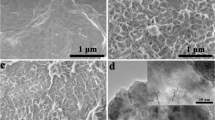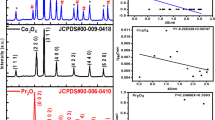Abstract
Polymer (acidic) electrolyte membrane water electrolysis suffers from insufficient catalyst activity, high cost of noble metal, and unsatisfactory durability, due to the sluggish reaction kinetics of oxygen evolution reaction and poor stability of catalysts under harsh operating environments. Aiming to enhance the utilization and durability of noble metals, a mesoporous Sb-doped SnO2 material with high surface area and conductivity was synthesized via soft-template method to support IrO2 catalyst. Physical characterization reveals that the as-prepared composite exhibits a rough morphology with the weak crystallinity IrO2 upper layer covering the rutile SnO2 crystalline phase. Electrochemical test for the IrO2-loading-dependant activity finds that both the area-free activity and mass-specific current on the 31 wt% sample are the optimal, meaning the excellent dispersion effect coming from the mesoporous Sb-SnO2 support and the synergy between the catalytic particles and Sb dopant. In addition, the enhancement in mass transfer efficiency and conductivity coming from the porous, IrO2-covered cross-linked morphology and the support-active component interaction, the supported IrO2 with 50 wt% loading marks the maximum normalized charge (227 C g−1 IrO2) and the highest apparent current at 1.75 V. What is more, this composite catalyst with the noble metal oxide coating is much more durable during continuous oxygen evolution procedure under a constant potential of 1.6 V because of the anchor effect from the carrier on the catalyst and a protective effect from the noble metal layer on the non-acid-tolerant support.












Similar content being viewed by others
References
Li X, Hao X, Abudula A, Guan G (2016) Nanostructured catalysts for electrochemical water splitting: current state and prospects. J Mater Chem A 4:11973–12000
Kadakia KS, Jampani PH, Velikokhatnyi OI, Datta MK, Park SK, Hong DH (2014) Nanostructured F doped IrO2 electro-catalyst powders for PEM based water electrolysis. J Power Sources 269:855–865
Audichon T, Guenot B, Baranton S, Cretin M, Lamy C, Coutanceau C (2017) Preparation and characterization of supported RuxIr(1−x)O2 nano-oxides using a modified polyol synthesis assisted by microwave activation for energy storage applications. Appl Catal B Environ 200:493–502
Nong HN, Oh H, Reier T, Willinger E, Willinger M, Petkov V, Teschner D, Strasser P (2015) Oxide-supported IrNiOx core–shell particles as efficient, cost-effective, and stable catalysts for electrochemical water splitting. Angew Chem Int Ed 54:2975–2979
Hu W, Wang Y, Hu X, Zhou Y, Chen S (2012) Three-dimensional ordered macroporous IrO2 as electrocatalyst for oxygen evolution reaction in acidic medium. J Mater Chem 22:6010–6016
Trasatti S (1991) Physical electrochemistry of ceramic oxides. Electrochim Acta 36:225–241
Gonzalez-Huerta RG, Ramos-Sanchez G, Balbuena PB (2014) Oxygen evolution in Co-doped RuO2 and IrO2: experimental and theoretical insights to diminish electrolysis overpotential. J Power Sources 268:69–76
Audichon T, Morisset S, Napporn T, Kokoh KB, Comminges C, Morais C (2015) Effect of adding CeO2 to RuO2–IrO2 mixed nanocatalysts: activity towards the oxygen evolution reaction and stability in acidic media. ChemElectroChem 2:1128–1137
Fabbri E, Habereder A, Waltar K, Kötz R, Schmidt TJ (2014) Developments and perspectives of oxide-based catalysts for the oxygen evolution reaction. Catal Sci Technol 4:3800–3821
Gaudet J, Tavares AC, Trasatti S, Guay D (2005) Physicochemical characterization of mixed RuO2–SnO2 solid solutions. Chem Mater 17:1570–1579
Sun W, Song Y, Gong X, Cao L, Yang J (2016) Hollandite structure Kx≈0.25IrO2 catalyst with highly efficient oxygen evolution reaction. ACS Appl Mater Interfaces 8:820–826
Sardar K, Ball SC, Sharman JD, Thompsett D, Fisher JM, Smith RA, Biswas PK, Lees MR, Kashtiban RJ, Sloan J (2012) Bismuth iridium oxide oxygen evolution catalyst from hydrothermal synthesis. Chem Mater 24:4192–4200
Li G, Yu H, Song W, Dou M, Li Y, Shao Z, Yi B (2012) A hard-template method for the preparation of IrO2, and its performance in a solid-polymer-electrolyte water electrolyzer. Chemsuschem 5:858–861
Nong HN, Gan L, Willinger E, Teschner D, Strasser P (2014) IrOx core-shell nanocatalysts for cost- and energy efficient electrochemical water splitting. Chem Sci 5:2955–2963
Hu W, Zhong H, Liang W, Chen S (2014) Ir-surface enriched porous Ir-Co oxide hierarchical architecture for high performance water oxidation in acidic media. ACS Appl Mater Interfaces 6:12729–12736
Saito A, Tsuji H, Shimoyama I, Shimizu K, Nishina Y (2015) Highly durable carbon-supported Pt catalysts prepared by hydrosilane-assisted nanoparticle deposition and surface functionalization. Chem Commun 51:5883–5886
Nan L, Yue W, Jiang Y (2015) Fabrication of graphene-porous carbon–Pt nanocomposites with high electrocatalytic activity and durability for methanol oxidation. J Mater Chem A 3:22170–22175
Wang XD, Liu GY, Xu JY, Jiang JM, Huang M, Li QF (2014) Microstructure control and performance of electrocatalysis composite materials foe oxygen evolution reaction (OER) on proton exchange membrane water electrolysis. Sci China Chem 44:1241–1254
Wang L, Lettenmeier P, Golla-Schindler U, Gazdzicki P, Cañas NA, Morawietz T, Hiesgen R, Hosseiny SS, Gago AS, Friedrich KA (2016) Nanostructured Ir-supported on Ti4O7 as a cost-effective anode for proton exchange membrane (PEM) electrolyzers. Phys Chem Chem Phys 18:4487–4495
Hao C, Lv H, Mi C, Song Y, Ma J (2016) Investigation of mesoporous niobium-doped TiO2 as an oxygen evolution catalyst support in an SPE water electrolyzer. ACS Sustain Chem Eng 4:746–756
Oh HS, Nong HN, Strasser P (2015) Preparation of mesoporous Sb-, F-, and in-doped SnO2 bulk powder with high surface area for use as catalyst supports in electrolytic cells. Adv Funct Mater 25:1074–1081
Hu W, Chen S, Xia Q (2014) IrO2/Nb–TiO2 electrocatalyst for oxygen evolution reaction in acidic medium. Int Hydrogen Energy 39:6967–6976
Kim HW, Kim HS, Na HG, Yang JC, Kebede MA, Lee C (2011) Growth of Sb2O3 submicron rods by the thermal evaporation of a mixture of Zn and Sb powders. Ceram Int 37:593–598
Krishnakumar T, Jayaprakash R, Pinna N, Phani AR, Passacantando M, Santucci S (2009) Structural, optical and electrical characterization of antimony-substituted tin oxide nanoparticles. J Phys Chem Solids 70:993–999
Rockenberger J, Felde UZ, Tisher M, Troger L, Hasse M, Weller H (2000) Near edge X-ray absorption fine structure measurements (XANES) and extended x-ray absorption fine structure measurements (EXAFS) of the valence st ate and coordination of antimony in doped nanocrystalline SnO2. J Chem Phys 112:4296–4308
Babar AB, Shinde SS, Moholkar AV, Bhosale CH, Kim JH, Rajpure KY (2010) Structural and optoelectronic properties of antimony incorporated tin oxide thin films. J Alloy Comp 505:416–422
Nguyen TD, Scherer GG, Xu ZJ (2016) A facile synthesis of size-controllable IrO2 and RuO2 nanoparticles for the oxygen evolution reaction. Electrocatalysis 7:420–427
Noonuruk R, Vittayakorn N, Mekprasart W, Sritharathikhun J, Pecharapa W (2015) Sb-doped SnO2 nanoparticles synthesized by sonochemical-assisted precipitation process. J Nanosci Nanotechnol 15:2564–2569
Shanthi S, Subramanian C, Ramasamy P (1999) Growth and characterization of antimony doped tin oxide thin film. J Cryst Growth 197:858–864
Gregg SJ, Sing KSW, Salzberg HW (1967) Adsorption surface area and porosity. J Electrochem Soc 114:279C
Brunauer S, Deming LS, Deming WE, Teller E (1940) On a theory of the van der Waals adsorption of gases. J Am Chem Soc 62:1723–1732
Chang SS, Clair B, Ruelle J, Beauchêne J, Renzo FD, Quignard F, Zhao GJ, Yamamoto H, Gril J (2009) Mesoporosity as a new parameter for understanding tension stress generation in trees. J Exp Bot 60:3023–3030
Eager CD, Riggs WM, Davis LE et al (1978) Handbook of X-ray photoelectron spectroscopy. Perkin-Elmer, Waltham
Augustynski J, Koudelka M, Sanchez J (1984) ESCA study of the state of iridium and oxygen in electrochemically and thermally formed iridium oxide films. J Electroanal Chem 160:233–248
Chen RS, Huang YS, Liang YM, Tsai DS, Chi Y, Kai JJ (2003) Growth control and characterization of vertically aligned IrO2 nanorods. J Mater Chem 13:2525–2529
Atanasoska L, Atanasoska R, Trasatti S (1990) XPS and AES study of mixed layers of RuO2 and IrO2. Vacuum 40:91–94
Lee WH, Kim H (2011) Oxidized iridium nanodendrites as catalysts for oxygen evolution reactions. Catal Commun 12:408–411
Xu J, Aili D, Li Q, Christensen E, Jensen JO, Zhang W, Hansen MK, Liu G, Wang X, Bjerrum NJ (2014) Oxygen evolution catalysts on supports with a 3-D ordered array structure and intrinsic proton conductivity for proton exchange membrane steam electrolysis. Energy Environ Sci 7:820–830
Ouattara L, Fierro S, Frey O, Koudelka M, Comninellis C (2009) Electrochemical comparison of IrO2 prepared by anodic oxidation of pure iridium and IrO2 prepared by thermal decomposition of H2IrCl6 precursor solution. J Appl Electrochem 39(8):1361–1367
Oh HS, Nong HN, Reier T, Gliech M, Strasser P (2015) Oxide-supported Ir nanodendrites with high activity and durability for the oxygen evolution reaction in acid PEM water electrolyzers. Chem Sci 6:3321–3328
Kong FD, Liu J, Ling AX, Xu ZQ, Wang HY, Kong QS (2015) Preparation of IrO2 nanoparticles with SBA-15 template and its supported Pt nanocomposite as bifunctional oxygen catalyst. J Power Sources 299:170–175
Marshall AT, Haverkamp RG (2010) Electrocatalytic activity of IrO2–RuO2 supported on Sb-doped SnO2 nanoparticles. Electrochim Acta 55:1978–1984
Oh HS, Nong HN, Reier T, Bergmann A, Gliech M, Araújo JF, Willinger E, Schlögl R, Teschner D, Strasser P (2016) Electrochemical catalyst–support effects and their stabilizing role for IrOx nanoparticle catalysts during the oxygen evolution reaction. J Am Chem Soc 138:12552–12563
Reier T, Oezaslan M, Strasser P (2012) Electrocatalytic oxygen evolution reaction (OER) on Ru, Ir, and Pt catalysts: a comparative study of nanoparticles and bulk materials. ACS Catal 2:1765–1772
Da Silva LA, Alves VA, Da Silva MAP, Trasatti S, Boodts JFC (1997) Oxygen evolution in acid solution on IrO2 + TiO2 ceramic films. A study by impedance, voltammetry and SEM. Electrochim Acta 42:271–281
Papaderakis A, Pliatsikas N, Prochaska Ch, Vourlias G, Patsalas P, Tsiplakides D, Balomenou S, Sotiropoulos S (2016) Oxygen evolution at IrO2 Shell–Ir–Ni core electrodes prepared by galvanic replacement. J Phys Chem C 120:19995–20005
Kadakia K, Datta MK, Velikokhatnyi OI, Jampani P, Park SK, Chung SJ, Kumta PN (2014) High performance fluorine doped (Sn, Ru)O2 oxygen evolution reaction electro-catalysts for proton exchange membrane based water electrolysis. J Power Sources 245:362–370
Acknowledgements
This work is supported by the National Natural Science Foundation of China (NSFC No. 21606075) and the Research Fund of Education Bureau of Hubei Province, China (Grant No. Q20141007). The authors would like to thank the workers in Shiyanjia Lab (www.shiyanjia.com) for the HRTEM observation.
Author information
Authors and Affiliations
Corresponding author
Ethics declarations
Conflict of interest
We declare that we have no financial and personal relationships with other people or organizations that can inappropriately influence our work and there is no professional or other personal interest of any nature or kind in any product, service, and/or company that could be construed as influencing the position presented in, or the review of, the manuscript entitled.
Rights and permissions
About this article
Cite this article
Tong, J., Liu, Y., Peng, Q. et al. An efficient Sb-SnO2-supported IrO2 electrocatalyst for the oxygen evolution reaction in acidic medium. J Mater Sci 52, 13427–13443 (2017). https://doi.org/10.1007/s10853-017-1447-1
Received:
Accepted:
Published:
Issue Date:
DOI: https://doi.org/10.1007/s10853-017-1447-1




